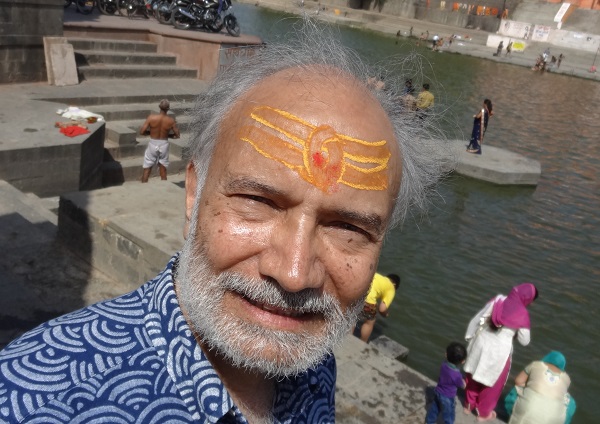What is Sarvapitri Amavasya (सर्वपित्री अमावस्या – all ancestors’ new moon day)?
The Shraadh (श्राध) is performed on the specific lunar day (तिथि) during the Pitru Paksha, when the ancestor—usually a parent or paternal grandparent—died. However, Sarvapitri Amavasya (all ancestors’ new moon day) is intended for all ancestors, irrespective of the lunar day they died. It is the most important day of the Pitru Paksha. Those who have forgotten to perform Shraadh can do so on this day. A Shraadh ritual performed on this day is considered as fruitful as one conducted in the holy city of Gaya, which is seen as a special place to perform the rite.
I may recall from ‘Guns & Glories’ that Dewan Karam Chand Bachhawat had three wives – Ajaib Devi, Jeeva Devi and Kapur Devi (Ajaibde, Jibade and Kapurde). He along with his family travelled to Gaya couple of times in 80s of 16th century to perform Shraadh tarpan for his ancestors. Similarly, in 1876, Mehta Murlidhar, father of Pradhan Rai Pannalal Mehta went to Gaya with his wife to perform Shraadh tarpan for his ancestors.
Pitru Paksha (पितृ पक्ष – literally “fortnight of the ancestors”) is a 15-lunar day period, (16 to 30 Sep, 2016) in Hindu calendar when Hindus pay homage to their ancestor (पितृ), especially through food offerings. Pitru Paksha is considered to be inauspicious, given the death rite performed during the ceremony, known as Shraadh or Tarpan.
It falls in the 2nd paksha (forthnight) of Hindu lunar month of Bhadrapada (September) and follows the fortnight immediately after the Ganesh festival. It begins on the first day of the fortnight ending with the new moon day known as Sarvapitri Amavasya.
Legend
When the legendary donor Karna died in the epic Mahabharata war, his soul transcended to heaven, where he was offered gold and jewels as food. However, Karna needed real food to eat and asked Indra, the lord of heaven, the reason for serving gold as food. Indra told Karna that he had donated gold all his life, but had never donated food to his ancestors in Shraadh. Karna said that since he was unaware of his ancestors, he never donated anything in their memory. To make amends, Karna was permitted to return to earth for a 15–day period, so that he could perform Shraadh and donate food and water in their memory. This period is now known as Pitru Paksha.
Pitru Paksha emphasises the fact that the ancestors and the current generation and their next unborn generation are connected by blood ties. The current generation repays their debt to the ancestors in the Pitru Paksha. This debt is considered of utmost importance along with a person’s debt to his gurus and his parents.
Who and for whom
It is essential that Shraadh be performed by the son—usually the eldest—or male relative of the paternal branch of the family, limited to the preceding three generations. However, on Sarvapitri amavasya, the daughter’s son can offer Shraadh for the maternal side of his family if a male heir is absent in his mother’s family. Some castes only perform the Shraadh for one generation. Prior to performing the rite, the male should have experienced a sacred thread ceremony.
Food
The food offerings made to the ancestors are usually cooked in silver or copper vessels and typically placed on a banana leaf or cups made of dried leaves. The food must include Kheer (a type of sweet rice and milk), lapsi (a sweet porridge made of wheat grains), rice, dal (lentils), the vegetable of spring bean (गवार) and a yellow gourd (कद्दू या भोपला).
Rites of Shraadh
 The male who performs the Shraadh should take a purifying bath beforehand and is expected to wear a dhoti. He wears a ring of kush grass. Then the ancestors are invoked to reside in the ring. The Shraadh is usually performed bare-chested, as the position of the sacred thread worn by him needs to be changed multiple times during the ceremony. The Shraadh involves pinda-daan, which is an offering to the ancestors of pindas (cooked rice and barley flour balls mixed with ghee and black sesame seeds), accompanying the release of water from the hand. It is followed by the worship of Vishnu in form of the darbha grass, a gold image or Shaligram stone and Yama. The food offering is then made, cooked especially for the ceremony on the roof. The offering is considered to be accepted if a crow arrives and devours the food; the bird is believed to be a messenger from Yama or the spirit of the ancestors. A cow and a dog are also fed, and Brahmin priests are also offered food. Once the ancestors (crow) and Brahmins have eaten, the family members can begin lunch.
The male who performs the Shraadh should take a purifying bath beforehand and is expected to wear a dhoti. He wears a ring of kush grass. Then the ancestors are invoked to reside in the ring. The Shraadh is usually performed bare-chested, as the position of the sacred thread worn by him needs to be changed multiple times during the ceremony. The Shraadh involves pinda-daan, which is an offering to the ancestors of pindas (cooked rice and barley flour balls mixed with ghee and black sesame seeds), accompanying the release of water from the hand. It is followed by the worship of Vishnu in form of the darbha grass, a gold image or Shaligram stone and Yama. The food offering is then made, cooked especially for the ceremony on the roof. The offering is considered to be accepted if a crow arrives and devours the food; the bird is believed to be a messenger from Yama or the spirit of the ancestors. A cow and a dog are also fed, and Brahmin priests are also offered food. Once the ancestors (crow) and Brahmins have eaten, the family members can begin lunch.


